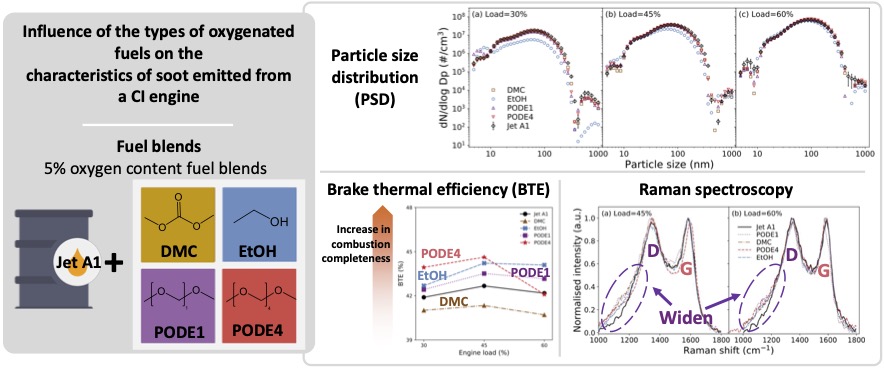Technical Report 298, c4e-Preprint Series, Cambridge
Influence of the types of oxygenated fuels on the characteristics of soot emitted from a CI engine
Reference: Technical Report 298, c4e-Preprint Series, Cambridge, 2022
- Blending PODE4 in Jet A1 can increase CI engine BTE by up to 4.8% at engine load 30%
- Soot samples from oxygenated fuels especially PODE1 are more reactive and disordered
- Chemical properties of oxygenated fuels are vital in affecting soot characteristics
 Dimethyl carbonate (DMC), ethanol (EtOH), polyoxymethylene dimethyl ether 1 (PODE1) and polyoxymethylene dimethyl ether 4 (PODE4) were blended with Jet A1 into fuel mixes with 5% oxygen content to investigate the effect of the oxygenated fuels on the soot produced from a compression ignition engine. Particle size distribution (PSD) was measured using a differential mobility spectrometer. Thermogravimetric analysis (TGA), Raman spectroscopy, ultraviolet-visible spectroscopy (UV-Vis) and Fourier transform infrared (FT-IR) spectroscopy were performed on the soot collected. PSD measurements showed that the addition of EtOH promoted the formation of nucleation mode particles. Based on measurements from Raman spectroscopy, the soot from oxygenated fuel blends is more disordered than Jet A1. Meanwhile, TGA showed that the soot from oxygenated fuel blends oxidises at a lower temperature than Jet A1. The lowered oxidation temperature of soot from oxygenated fuel blends coincides with the presence of a higher proportion of oxygen functional groups in FT-IR spectra for oxygenated fuel soot samples. Lastly, the conjugation length of the soot aromatic structure for the organic carbons (derived from the optical band gap of UV-Vis) is greater for the oxygenated fuel blends, indicating that the growth of organic carbons is enhanced for oxygenated fuel blends. The blending of oxygenated fuels influences soot properties through the dilution effect, combustion condition effect and chemical effect. Particularly, the type and characteristics of oxygenated species from the decomposition of the oxygenated fuels during combustion can considerably affect the soot properties during combustion.
Dimethyl carbonate (DMC), ethanol (EtOH), polyoxymethylene dimethyl ether 1 (PODE1) and polyoxymethylene dimethyl ether 4 (PODE4) were blended with Jet A1 into fuel mixes with 5% oxygen content to investigate the effect of the oxygenated fuels on the soot produced from a compression ignition engine. Particle size distribution (PSD) was measured using a differential mobility spectrometer. Thermogravimetric analysis (TGA), Raman spectroscopy, ultraviolet-visible spectroscopy (UV-Vis) and Fourier transform infrared (FT-IR) spectroscopy were performed on the soot collected. PSD measurements showed that the addition of EtOH promoted the formation of nucleation mode particles. Based on measurements from Raman spectroscopy, the soot from oxygenated fuel blends is more disordered than Jet A1. Meanwhile, TGA showed that the soot from oxygenated fuel blends oxidises at a lower temperature than Jet A1. The lowered oxidation temperature of soot from oxygenated fuel blends coincides with the presence of a higher proportion of oxygen functional groups in FT-IR spectra for oxygenated fuel soot samples. Lastly, the conjugation length of the soot aromatic structure for the organic carbons (derived from the optical band gap of UV-Vis) is greater for the oxygenated fuel blends, indicating that the growth of organic carbons is enhanced for oxygenated fuel blends. The blending of oxygenated fuels influences soot properties through the dilution effect, combustion condition effect and chemical effect. Particularly, the type and characteristics of oxygenated species from the decomposition of the oxygenated fuels during combustion can considerably affect the soot properties during combustion.
Material from this preprint has been published in Fuel.
PDF (1.8 MB)



